Sustainable WPI

WPI has been actively engaged in creating and maintaining a sustainable campus for many years. If you can’t make it to campus to experience some of our initiatives in person, this tour goes location by location to show you some of the many ways we have worked to conserve energy and water and to promote sustainable activities across our community.
CONTACT
green@wpi.edu
A Step-by-Step Guide to Sustainability on Campus
Park Avenue Garage
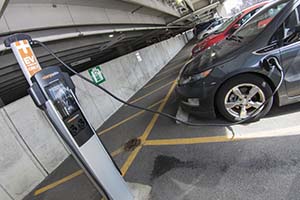
- Bike Fix-It Station: Biking to campus reduces the miles we drive in gas-powered vehicles, which produce about 20 percent of all carbon emissions. This station helps community members keep their bikes on the road by making minor repairs a breeze.
- Electric Vehicle Charging Stations: These three dual-charging stations are where employees and students may charge their electric vehicles, an environmentally friendly alternative to gas-powered transportation. Learn more about electric vehicles at WPI [link to Electric vehicles section of accordion on Transportation page].
- Zipcar Fleet: Members of the WPI community may leave their cars at home—or choose not to own one—thanks to this convenient, fuel-efficient vehicle-sharing option. Learn more and sign up for WPI’s Zipcars.
Higgins House

- Bioswale: Located between the garage access road and the Higgins House parking lot, this depression in the ground uses soil, plants, and woodchips to slow and filter stormwater flowing from the lot. Stormwater often contains harmful contaminants like oil and gas; the bioswale helps minimize pollution of our local water bodies. Learn more about the Great Problems Seminar project that created the bioswale.
- Formal Gardens: Located on the grounds of Higgins House, these gardens offer a restful oasis for our campus community.
Salisbury Laboratories
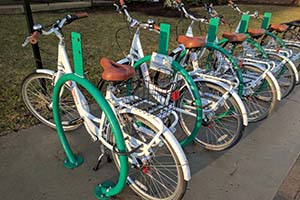
- Gompei’s Gears Bike Share: One of six campus locations for WPI’s bike share program (others are located at Unity Hall, Daniels Hall, Faraday Hall, South Village Fruit House and Gateway Park), where community members can get around campus and the city using free bicycles.
- Rooftop Greenhouse: WPI’s Department of Biology collaborates with Worcester’s Regional Environmental Council and YouthGROW Program to learn about plants and grow seedlings that are then sold at local farmers markets.
East Hall

- Green Roof: Located on top of East Hall (WPI’s second LEED-certified building), the green roof is home to a 5,000-square-foot garden composed of sedum, chives, and other plants, as well as a stormwater collection system that provides the Department of Civil and Environmental Engineering with the ability to study flow and quality of the drainage from the roof.
- LEED (Leadership in Energy and Environmental Design) Certification: East Hall is one of five LEED-certified buildings on campus. To earn LEED certification, buildings must be energy efficient, conserve resources, and contribute to the well-being of those who use them.
Innovation Studio
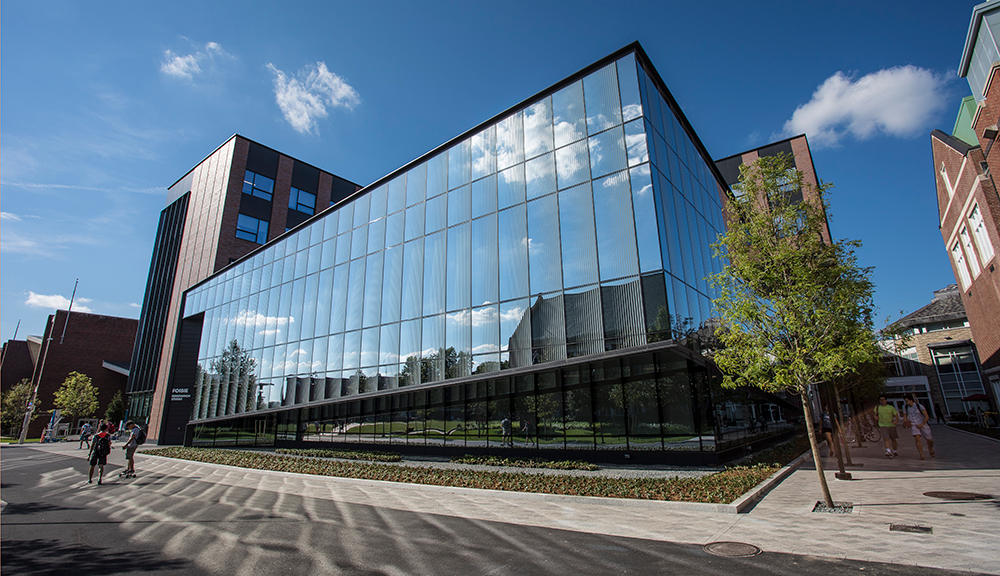
- LEED (Leadership in Energy and Environmental Design) Certification: The Innovation Studio is one of five LEED-certified buildings on campus. To earn LEED certification, buildings must be energy efficient, conserve resources, and contribute to the well-being of those who use them.
- Energy Saving Features: Energy usage is reduced by the building’s envelope design and its insulation value, the glass windows, the glass curtain wall (which has a high R-value and low solar heat gain coefficient), state-of-the-art heating and cooling, LED lighting, and occupancy sensors throughout the building.
- Sustainable Materials: Eighty percent of the wood used in the building is Forest Stewardship Council certified, meaning that the wood comes from responsibly managed forests. Sustainable content can also be found in the glass curtain wall, ceilings, window shades, and carpet tiles; 70 percent of the materials used in construction were manufactured within 500 miles of WPI.
Sports & Recreation Center
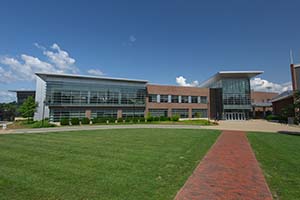
- Solar Water Heating: Solar panels on the roof heat the water for the swimming pool, greatly reducing the amount of electricity normally needed for this purpose.
- Lighting Controls: Daylight sensors automatically dim lights while occupancy sensors turn lights off after a space is vacated. These controls also help reduce electricity consumption.
- Water-Saving Restrooms: Waterless urinals, flushometers on toilets, and water-conserving faucets help reduce water use.
- Paperless Hand Drying: Specialized hand dryers are used in restrooms, reducing paper use and waste. They also cost less to operate than heated air hand dryers, generate fewer carbon emissions, and are more hygienic than paper towels.
- Sustainable and Recycled Materials: The use of bamboo on feature walls and some ceilings helps preserve hardwood forests (bamboo looks and acts like wood but can be harvested after only three years of growth as opposed to oak, which is harvested after 100). Countertops are also made from recycled glass mixed with a cement binder and pigment.
- Water Bottle Filling Stations: Over 50 water bottle filling stations have been installed around campus, including in the Sports & Recreation Center. They use a non-ozone-depleting refrigerant, are hands-free, and reduce the use and disposal of single-use bottles, which take hundreds of years to decompose.
Alumni Field
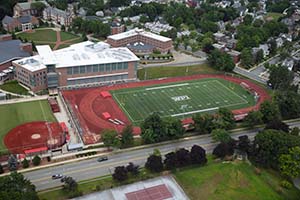
- Artificial Turf: The football field is covered in artificial turf rather than grass to reduce environmental impacts. It helps conserve water, and because it requires no fertilizers, pesticides, or irrigation, there are no carbon dioxide emissions generated by lawn care equipment.
Morgan Dining Hall
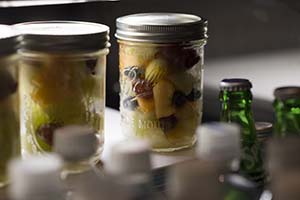
- Healthy Eating Choices: WPI’s state-of-the-art Pulse on Dining Marketplace offers healthy entrée choices, including vegetarian options, an allergy-specific food station, and the Eat Local program that supports local vendors and farmers.
- Reducing Food Waste: Rotting food produces methane, a greenhouse gas 20 times more harmful than carbon dioxide, so it’s important to minimize the amount of food sent into the waste stream. Through the WPI Food Recovery Network, leftover food from the Morgan Hall, the university’s main student dining facility is donated to Friendly House, a comprehensive social services hub that serves more than 25,000 city residents per year. Trimmings from food preparation and discarded food are also set aside for a local farmer to feed his pigs.
The Quadrangle
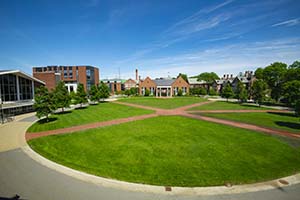
- Water Collection Cisterns: Two 25,000-gallon underground cisterns are located beneath the south end of the Quad, collecting rainwater from a drainage system in the Sports & Recreation Center for use in watering grass and plants around campus.
Faraday Hall
- Reclaimed Brownfield: A LEED-certified residence hall, Faraday was built on a reclaimed brownfield site and is another example of energy efficiency and resource-conserving design.
OASIS House
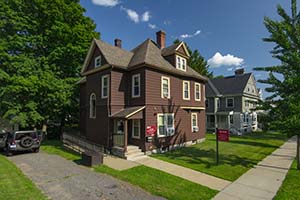
- Building Community: The OASIS (Offering Acceptance, Support, and Inclusion to Students) Multicultural Center offers a centralized location where students can meet and study in a welcoming, relaxed environment, giving them a place to build community.
Unity Hall
- LEED (Leadership in Energy and Environmental Design) Certification: Upon completion, the new academic and student services building known as Unity Hall will be the sixth LEED-certified building on campus. To earn LEED certification, buildings must be energy efficient, conserve resources, and contribute to the well-being of those who use them.
- Sustainable Materials: Many materials used in this project have been chosen for their minimal impact on the environment, such as Forest Stewardship Council wood products; products made from wood reclaimed on-site; paints, coatings, and adhesives with low levels of volatile organic carbons; and ceiling tiles made of 70–90 percent recycled materials.
- Efficient Features: Low-flow plumbing features, triple-glazed windows, shading, active chilled beams, passive reheating, HVAC zoning, LED lighting, high use of natural light, and more results in an overall Energy Use Intensity (EUI) 44 percent less than the baseline.